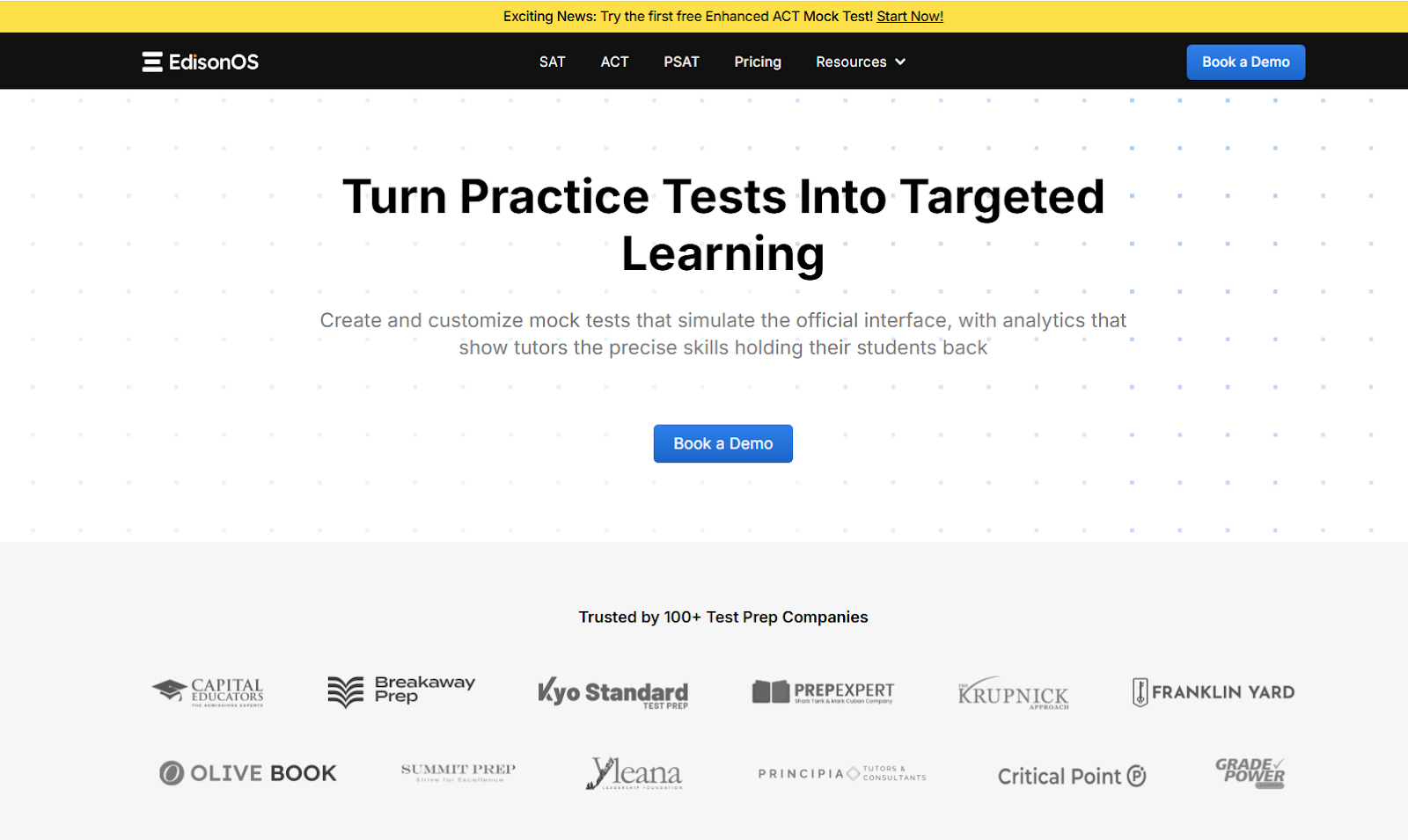




Key Takeaways
- Decode the Jargon: Understanding terms like raw scores, scaled scores, percentiles, and adaptive testing can help students, tutors, and parents make sense of test reports and reduce confusion.
- Make Smarter Prep Decisions: A clear grasp of how scoring works allows students to set realistic goals and focus on the right areas to improve.
- Know What Tests Are Measuring: Whether norm-referenced or criterion-referenced, each test type serves a purpose and knowing the difference helps interpret results more accurately.
Since the mid-1800s, standardized tests have been a cornerstone of American education, evolving significantly over the years. These assessments provide an objective and consistent way to measure student learning and academic achievement across different schools, districts, and states. They also help educators evaluate the effectiveness of their teaching methods and adjust curricula to meet educational standards.
But when you receive your child's standardized test report, the goal is simple: understand how well they performed. Unfortunately, standardized testing jargon—terms like percentile rank, raw scores, scaled scores, and norm-referenced versus criterion-referenced testing—often creates confusion instead of clarity.
Not understanding the language of standardized testing isn't just a minor inconvenience. It can impact critical decisions about educational planning, tutoring needs, and academic goals. When parents can't interpret score reports or students don't understand their results, valuable opportunities for improvement may be missed.
That's why decoding these terms matters for everyone involved—students preparing for exams, parents trying to support their children's academic journey, and educators working to explain results effectively.
In this comprehensive guide, we'll break down the most essential standardized testing terms into clear, practical language. By the end, you'll be able to read score reports with confidence and use this knowledge to make informed decisions about test preparation and academic planning.
What is a standardized test?
A standardized test is any assessment that is administered, scored and interpreted in a consistent, predetermined manner. This means that every student answers the same set of questions under the same conditions, and the scoring follows the same rules no matter where or when the test is taken.
These tests are designed to fairly and consistently evaluate the students' knowledge and skills nationwide. Educators can view reports on a student's progress and find out a trend of growth or decline. And they can modify their teaching strategies to help improve the students' performance.
Common formats of standardized tests
Standardized tests use various question formats to assess different types of knowledge and skills. Understanding these formats helps you prepare effectively and know what to expect on test day.
Why understanding standardized testing terms matters
Standardized test results arrive packed with numbers, percentiles, and technical terminology. Without understanding what these terms mean, it's surprisingly easy to misinterpret scores—and that confusion can have serious consequences.
These test scores often determine critical educational outcomes. They influence grade promotion decisions, graduation requirements, college admissions, scholarship eligibility, and even school funding allocations. When students, parents, or educators misunderstand what scores actually represent, they may make uninformed decisions about academic planning, course selection, or intervention strategies.
Multiple Reddit posts show students commonly struggling to distinguish between the raw and scaled results. Score confusion is more widespread than you might expect. Students frequently struggle to distinguish between different score types, leading to unnecessary stress or misplaced confidence.
For example, consider a student who receives a 1200 on the SAT. Without understanding that this represents a scaled score (not raw points), they might assume they answered 1200 questions correctly out of some larger total. In reality, this score likely represents performance better than about 75% of test-takers—a strong result that demonstrates solid college readiness.
Similarly, a student earning the 65th percentile might think they only answered 65% of questions correctly, when this actually means they performed better than 65% of their peers—quite different information that changes how the result should be interpreted.
When you decode standardized testing terminology, several positive outcomes emerge. Students can accurately assess their performance, set realistic goals, and reduce test-related anxiety. Parents gain the knowledge needed to advocate effectively for their children and make informed decisions about additional support or advanced opportunities.
Educators benefit by communicating results more clearly to families and using score data to identify specific areas where instruction can be improved. This shared understanding creates a foundation for collaborative efforts to support student success.
Core score types and what they mean
Score types at a glance
Understanding different score types is essential for interpreting test results accurately. Each type serves a specific purpose and provides different insights into student performance.
1. Raw scores
A raw score is simply the count of correct responses given by the student on a test. For example, if a test has 100 questions and you answer 70 correctly, your raw score is 70. This straightforward count represents your basic performance without any statistical adjustments.
The limitation in calculating raw scores is that they may vary depending on the test length and the difficulty. They don't allow fair comparison across different test forms or populations so they are often converted into scaled scores.
2. Scaled scores
Scaled scores are basically the same raw scores that are converted to fit a consistent score range. This makes it possible to fairly compare results even when different versions of the test vary in terms of difficulty.
Most standardized tests use specific scaled score ranges. For example, SAT sections use a 200-800 scale, while ACT composite scores range from 1-36. These consistent ranges mean a scaled score of 600 on the SAT Math section represents the same level of achievement whether you took the test in March or October, regardless of which version was more challenging.
The digital SAT uses section-adaptive testing, where each subject area (Reading & Writing, Math) contains two modules. Every student receives the same Module 1, but performance on this initial module determines whether you receive an easier or harder Module 2.
This creates an interesting scaling scenario: two students with identical raw scores could receive different scaled scores based on the difficulty level of their respective Module 2 questions. The College Board uses proprietary algorithms to ensure scaled scores accurately reflect ability level regardless of which difficulty path students followed.
3. Percentile ranks and normal curve equivalents
The percentile rank (PR) shows how a student performed compared to a reference group of test-takers. For example, if your percentile is 85, then it means you scored better than 85% of students in the comparison group. Importantly, this doesn't mean you answered 85% of questions correctly—it's purely about relative performance.
You can't add or average these ranks easily to see how the whole class is doing. So, the percentile rank is good for comparing one student to others, not for tracking progress over time. The gap between the 45th and 55th percentiles represents a smaller performance difference than the gap between the 85th and 95th percentiles.
Normal curve equivalents (NCEs) are like percentiles, but they follow a bell curve. NCE scores also go from 0 to 100, but they are spaced out evenly, unlike percentiles. It makes NCEs better for tracking how a group, like a whole class or school, is doing over time because you can average NCEs.
4. Cut scores & achievement levels
Cut scores are defined thresholds used to classify student performance into levels like Basic, Proficient, or Advanced. These scores represent the minimum points needed to reach each performance level.
For example, a state assessment might set these cut scores:
- Basic: 200-249 points
- Proficient: 250-299 points
- Advanced: 300+ points
Achievement Levels are what the students should know and be able to do at each performance level. These descriptors translate numerical scores into meaningful academic expectations.
The National Assessment Governing Board (NAEP) provides widely-used achievement level definitions that help educators and families understand whether students are meeting grade-level expectations. Understanding these different score types helps you interpret results more accurately and make informed decisions about academic planning and support needs.
Norm-referenced vs. criterion-referenced tests
Standardized tests fall into two fundamental categories based on how they interpret student performance. Understanding this distinction helps you interpret what your scores actually mean and how they'll be used.
Norm-referenced tests (NRTs)
Norm-referenced tests compare your performance to that of other test-takers, showing where you rank within a specific group. Your score's meaning depends entirely on how others performed—it's all about relative standing rather than absolute knowledge.
These tests are designed so that scores naturally spread out in a bell curve distribution. By design, half of test-takers will score above the median and half below. If you score in the 80th percentile, you performed better than 80% of students in the reference group, but this doesn't indicate how many questions you answered correctly.
Norm-referenced tests excel at ranking students for competitive selections like college admissions or scholarship awards. They help identify top performers and compare students from different educational backgrounds.
However, they don't indicate whether students have mastered specific skills or content—a student could score in the 90th percentile without demonstrating proficiency in key subject areas.
Criterion-Referenced Tests (CRTs)
Criterion-referenced tests measure your performance against predetermined standards or learning objectives, regardless of how other students perform. These tests answer the question: "Can this student demonstrate mastery of specific skills or knowledge?"
Performance levels are established before testing begins, based on what educators believe students should know and be able to do. Theoretically, all students could achieve proficiency, or none could—the results depend on individual mastery rather than group comparisons.
Criterion-referenced tests provide clear information about what students have actually learned and can do. They're valuable for diagnosing specific learning needs and measuring progress toward educational goals. However, they may not help with competitive decisions like college admissions, where relative ranking matters more than absolute achievement.
Types of standardized tests
Standardized tests come in various forms, each designed to serve specific educational purposes. Understanding these different types helps you interpret results appropriately and know what to expect from each assessment.
1. Achievement tests
This test assesses what students have already learned in school, like math, reading, or science. These assessments evaluate whether students have mastered specific curriculum content and are meeting expected learning standards for their grade level.
Achievement tests are typically criterion-referenced, meaning your performance is compared against predetermined learning objectives rather than other students' scores. Most state accountability assessments and end-of-course exams fall into this category.
2. Aptitude tests
Aptitude tests attempt to predict future academic performance by measuring general cognitive abilities and learning potential, rather than specific subject knowledge. These assessments evaluate reasoning skills, problem-solving abilities, and capacity for learning new material.
Unlike achievement tests, aptitude tests are designed to be relatively independent of specific curriculum content. The SAT and ACT, while sometimes called achievement tests, function more like aptitude tests since they measure general academic readiness rather than mastery of particular courses.
3. High-stakes vs. low-stakes tests
High-stakes tests are standardized assessments where the results carry significant consequences for students, educators, or schools. These outcomes may include determining a student's promotion to the next grade level, graduation eligibility, or admission to specific academic programs. The pressure associated with these tests can influence curriculum decisions and create anxiety for test-takers.
Low-stakes tests are assessments that have minimal or no direct consequences for the student or school. Their primary purpose is to inform instruction, provide feedback, and guide future learning strategies. They are used by teachers to monitor student progress throughout the school year.
4. Adaptive testing and computer-adaptive tests
Adaptive testing uses technology to personalize the testing experience by adjusting question difficulty based on student responses. There are two main types:
a) Question-adaptive tests (like the GRE or GMAT) change difficulty after each individual question. Answer correctly, and the next question becomes more challenging; answer incorrectly, and you receive an easier question.
b) Section-adaptive tests (like the digital SAT) adjust difficulty between larger modules or sections. All students receive the same initial module, but performance determines whether they receive a more challenging or less difficult subsequent module.
5. Constructed-response vs. multiple-choice
Constructed-response questions require students to generate original answers in their own words, such as essays, mathematical solutions, or short explanations. These questions assess deeper understanding, critical thinking, and communication skills.
Scoring can be analytic (evaluating specific components like grammar, evidence, or mathematical reasoning separately) or holistic (assessing overall quality with a single score).
Multiple-choice questions present students with several predetermined answer options, typically requiring them to select the single best response. While efficient to administer and score objectively, these questions may not capture the depth of student understanding that constructed-response items can reveal.
Most comprehensive standardized tests use a combination of both formats to balance efficiency with meaningful assessment of student capabilities.
Testing Accommodations and Fairness
Testing accommodations are modifications to standard test administration procedures that help ensure fair assessment for all students, particularly those with disabilities or special needs. These changes alter how a test is given without changing what the test measures or the content being assessed.
They provide equal access to assessments by removing barriers that might prevent students from demonstrating their true knowledge and abilities.
Common accommodations include:
- Extended time for students who process information more slowly
- Read-aloud support for students with dyslexia or other reading difficulties
- Braille or large-print versions for students with visual impairments
- Separate testing rooms to minimize distractions for students with attention disorders
- Assistive technology such as screen readers or voice recognition software
- Frequent breaks for students with medical conditions or attention difficulties.
The key principle is that accommodations level the playing field without giving unfair advantages or making the test easier.
Reliability and validity in testing
Reliability refers to a test's consistency—whether it produces similar results when administered multiple times under similar conditions. A reliable test measures student performance consistently, regardless of when or where it's taken.
Validity means a test accurately measures what it claims to measure. A valid reading comprehension test should assess reading skills, not background knowledge or test-taking strategies.
When properly implemented, accommodations actually improve test validity by ensuring that results reflect students' knowledge and skills rather than their disabilities. Without accommodations, test scores might measure a student's disability rather than their academic achievement, compromising the validity of results.
Test bias and equity considerations
Test bias occurs when assessment results systematically favor or disadvantage certain groups of students for reasons unrelated to what the test is supposed to measure. Without appropriate accommodations, standardized tests may unfairly disadvantage students with disabilities, English language learners, or students from different cultural backgrounds.
Well-designed accommodations help eliminate bias by:
- Removing barriers that prevent students from accessing test content
- Ensuring that test results reflect academic knowledge rather than disability-related challenges
- Providing multiple ways for students to demonstrate their understanding
The challenge lies in providing meaningful accommodations without fundamentally altering what the test measures. Accommodations must be:
- Individualized based on documented needs and regular classroom supports
- Appropriate for the specific disability without changing content difficulty
- Validated to ensure they don't provide unfair advantages to students who receive them.
Effective accommodation practices require collaboration between educators, assessment specialists, and families to determine appropriate supports. The goal is creating testing conditions that allow all students to demonstrate their true capabilities while maintaining the integrity and comparability of test results.
When accommodations are thoughtfully designed and properly implemented, they enhance both the fairness and accuracy of standardized testing for all students.
How to interpret your standardized test scores
Understanding your standardized test scores requires more than just looking at the overall number. A systematic approach to score interpretation helps you identify strengths, pinpoint areas for improvement, and make informed decisions about your academic future.
Start with the key components
When reviewing your score report, begin by understanding these essential elements:
Overall scores: Your total or composite score provides a general performance snapshot, but it's just the starting point for deeper analysis.
Section scores: Break down your performance by subject areas (Math, Reading, Writing, Science) to identify specific strengths and weaknesses. These section-level results often reveal patterns that the overall score masks.
Subscores and cross-test scores: Many tests provide detailed breakdowns within sections, such as "Heart of Algebra" or "Problem Solving and Data Analysis" on the SAT. These granular insights help pinpoint exactly which skills need attention.
Percentile ranks: While your scaled score shows absolute performance, percentiles reveal how you performed relative to other test-takers. Remember, a 75th percentile means you scored better than 75% of students—not that you answered 75% of questions correctly.
While your scaled scores and percentiles provide important baseline information, the real insights come from digging deeper into the patterns and details hidden within your score report:
Error analysis: Review which types of questions you missed. Were they content-based errors (didn't know the material) or process-based errors (misread questions, made calculation mistakes)?
Timing patterns: Consider whether you ran out of time or felt rushed. Some students perform well on attempted questions but struggle with pacing.
Consistency across sections: Large variations between section scores may indicate specific skill gaps or test-taking strategy issues rather than overall ability differences.
Avoid these common interpretation pitfalls:
Over-relying on superscores: While many colleges accept superscores (your highest section scores across multiple test dates), don't assume this strategy will dramatically improve your profile. Focus on consistent, well-rounded performance rather than gaming the system.
Score choice isn't always beneficial: Just because you can choose which scores to send doesn't mean you should take tests repeatedly hoping for improvement. Each test administration requires significant preparation time and creates additional stress.
Single test limitations: One test score doesn't define your academic potential. Consider your score in context with your grades, coursework, and other achievements.
Digital tools & resources
Modern technology has transformed how students prepare for standardized tests and interpret their results. Digital platforms now offer sophisticated tools that demystify complex testing terminology while providing personalized learning experiences.

EdisonOS exemplifies how digital tools can bridge the gap between understanding testing concepts and achieving score improvements. It serves tutoring companies by providing authentic test preparation experiences for major standardized assessments including the Digital SAT, ACT, AP exams, and SHSAT.
Besides providing a clear understanding of complex standardized testing terms, our platform mirrors the real test environments of Bluebook and the digital ACT with adaptive learning tools, which helps students get a real test experience.
We provide detailed reports for every mock test taken, which break down the strengths and weaknesses based on the skill, section, time taken, and even question difficulty. So, with these insights, tutors can help their students focus on the areas that need improvement. At the same time, parents get clear details on their child's performance.
Tutors can create their own tests using either EdisonOS's huge question library or upload their own questions in less time. Plus, they can customize the scaled score and create more tests that target a specific skill that the student is lacking. In short, this tool helps students clearly understand complex testing terms.
Advanced analytics and reporting
Digital platforms excel at translating raw performance data into meaningful insights. Comprehensive score reports break down student performance across multiple dimensions:
- Skill-based analysis showing mastery levels in specific content areas
- Section performance highlighting strengths and weaknesses by test component
- Time management insights revealing pacing patterns and efficiency
- Question difficulty correlation demonstrating performance across various challenge levels
These detailed breakdowns help students, parents, and tutors move beyond simple percentile ranks to understand exactly what scores mean and where improvement efforts should focus.
Customizable assessment tools
Modern platforms offer flexibility that traditional test prep materials cannot match. Tutors can create targeted assessments using extensive question libraries or upload their own materials, reducing test creation time from hours to minutes.
Advanced features include customizable scaled scoring systems that allow tutors to simulate various difficulty levels and create focused practice sessions targeting specific skill gaps identified through previous assessments.
Benefits for all stakeholders
- For students: Digital tools provide immediate feedback, personalized learning paths, and clear explanations of testing terminology in context rather than as abstract concepts.
- For parents: Detailed, visual reports translate technical testing language into understandable insights about their child's academic progress and preparation needs.
- For educators: Comprehensive analytics support data-driven instruction decisions and enable more effective communication with families about student performance and goals.
Beyond comprehensive platforms, several authoritative sources provide reliable information about standardized testing terminology:
- Educational Testing Service (ETS) glossary offers official definitions of testing terms and measurement concepts
- College Board resources provide detailed explanations of SAT scoring and terminology
- State education department websites explain local assessment terminology and achievement level descriptions.
Choosing the right standardized testing preparation tools
When selecting digital resources for test preparation or score interpretation, look for platforms that:
- Provide clear explanations of testing terminology alongside practice opportunities
- Offer detailed analytics that translate scores into actionable insights
- Mirror authentic testing conditions and formats
- Include comprehensive reporting features for students, parents, and educators
The goal is finding tools that not only improve test performance but also enhance understanding of what standardized test results actually mean—turning complex terminology into practical knowledge that supports better educational decision-making.
Final Words
Understanding standardized testing terminology—raw scores, scaled scores, percentiles, and adaptive testing—transforms confusing jargon into valuable insights. When students, parents, and educators decode these terms, they can set realistic goals, reduce test anxiety, and make informed decisions about academic planning and preparation.
While testing companies keep their exact formulas secret, knowing how these systems work helps you interpret results appropriately and focus your efforts effectively. Remember, standardized test scores provide important information but don't define a student's potential.
Use this knowledge to approach testing with confidence. Whether you're preparing for exams, supporting your child's journey, or guiding students as an educator, understanding testing terminology empowers better decisions and outcomes.
EdisonOS offers comprehensive test preparation tools that demystify standardized testing while providing authentic practice experiences. Our detailed analytics translate complex terminology into actionable insights for students, parents, and tutors.
Subscribe to
our Newsletter
Subscribe to our Newsletter
To know about the latest Insights & updates of EdisonOS!
Recommended Reads
Recommended Podcasts










.png)
.webp)
